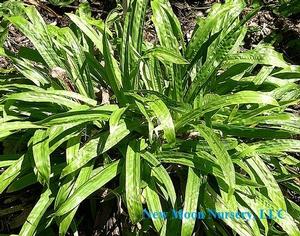Printed at http://www.newmoonnursery.com/index.cfm/
Carex plantaginea
Seersucker sedge
Native to North America
FIRST IMPRESSIONS: Carex plantaginea is perhaps the most ornamental of the woodland sedges. This is a petite perennial sedge that forms 1’ clumps of lush shaggy foliage. The leaves are broad and semi-evergreen with a striking lime green color and puckered surface. In mid-spring reddish purple scaly flower spikes are displayed above the foliage. This sedge prefers partly shaded moist fertile woods but will tolerate difficult dry shaded sites.
HABITAT & HARDINESS: Carex plantaginea is native to eastern North Ameriaca from Ontario to Quebec and Nova Scotia. In the United States, range extends from Maine to South Carolina and west to Minnesota and Alabama. The greatest distribution is in the Northeastern U. S., in states bordering the Great Lakes and in the Appalachian Mountains.
Plants are indigenous to woodland slopes, rich deciduous woods, ravines and wooded mountainous sites.
This sedge is hardy from USDA Zones 4-8.
PLANT DESCRIPTION: Carex plantaginea grows in dense clumps of bold strap shaped foliage.
Leaves are shiny and bright green. Blades have 3 prominent longitudinal veins and are dimpled or puckered along each. Leaves average 1’ long and about 1” wide. Foliage is wider than that of many other sedges and evergreen through most of the range. Blades emerge from leaf sheaths that have a unique maroon color.
In mid-spring maroon and green striped culms bear terminal purplish staminate (male) spikelets with pistillate (female) spikelets below. The spikelets are upright and cylindrical. Pistillate spikelets contain up to 12 blunt tipped purplish perigynia.
By mid-summer, achene fruit has matured inside the perigynia and the culm topples onto the forest floor and disappears.
This sedge is about 1’ tall with an equal or wider spread. In flower, the short lived culms rise almost to 2’.
CULTURAL & MAINTENANCE NEEDS: Carex plantaginea prospers in moist woodlands especially those with rich calcareous soil. The preferred exposure is light to medium shade. Plants tolerate rocky or alkaline soil and some drought. This sedge will adapt to difficult dry shaded sites.
Plants slowly colonize from short rhizomes and by producing occasional seedlings.
Established plants are pest resistant and unpalatable to deer and other herbivores.
In garden situations, plants should be cut to the ground during late winter before new growth is initiated.
LANDSCAPE USES: Carex plantaginea is a bold textural Accent for Shade Gardens. Plants are often used as a Groundcover, Butterfly Host Plant or as a Border along woodland trails. This sedge is lovely when Grouped or Massed in Wildlife Gardens. Plants provide Erosion Control, Winter Interest and are appropriate for Deer Resistant Plantings, Low Maintenance Plantings or Rock Gardens.
This species is an excellent native substitute for the popular Asian groundcovers Liriope muscari and Ophiopogon japonicus.
COMPANION & UNDERSTUDY PLANTS: Suitable garden companions for Carex plantaginea could include: Heuchera americana ‘Dale’s Strain’, Iris cristata, Phlox divaricata, Viola walteri ‘Silver Gem’, Spigelia marilandica, and Polystichum acrostichoides.
Both Carex flaccosperma and Carex laxiculmis have similar cultural needs but both have narrower leaves with a bluish tint.
TRIVIA: Caterpillars of several woodland butterflies feed on the foliage. The seeds are a food source for woodland birds including wild turkey.
Height:
6-12 inSpread:
10-12 inSpacing:
12-24 inUSDA Hardiness Zone:
4-8Bloom Color:
GreenCarex plantaginea Characteristics
Attributes
- Rock Garden
- Ground Cover
Exposure
- Partial Shade to Full Shade
Flowering Months
- May
Grass Season
- Cool Season Grass
Groundcover Foot-Traffic Tolerances
- Light
Lawn Replacement or Groundcover
- Groundcover
Soil Moisture Preference
- Moist
Interesting Notes:
For more information on this plant, visit the USDA PLANTS Database: http://plants.usda.gov/java/profile?symbol=CAPL4

